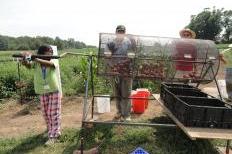







It’s no surprise there are 54 community gardens in Madison proper alone, according to Taylar Foster, a graduate student in the Department of Urban and Regional Planning at UW since a community garden is any plot of land gardened by multiple people. Community gardens are seeded at schools and churches, on public property and private property. The oldest in the state, Eagle Heights Community Garden, began in Madison in 1962.
Twelve years ago Lacy Garden began on 1.25 acres of land donated by the Lacy family out of a desire to help Madison’s hungry.

Now the garden, located at 5879 Whalen Road in Fitchburg, relies on volunteers to produce fresh produce for St. Vincent de Paul food pantry. Last year they produced 24,800 pounds of fresh food for St. Vinnys and its customers. According to Tom Parslow, the current garden manager, Lacy Garden’s contribution makes up the vast majority of the veggies donated to the food pantry.
“It’s really more of a commercial farm for the food pantry than a community garden,” said Parslow.
Lacy Garden is one of three called the Madison Food Pantry Gardens, dedicated to providing for area food pantries. In sum, the three gardens grow 75,000 pounds of food annually on just four acres.
Just over a year ago, St. Vincent de Paul built larger refrigerated storage, allowing the food shelter to accept fresh vegetable donations directly instead of relying on programs like Second Harvest.
Lacy Garden delivers a diverse crop to the new fridges. Just this year, volunteers have planted melons, sweet corn, onions, pumpkins, tomatoes, potatoes, cabbage, broccoli, beans, rutabaga, carrots, squash, Brussels sprouts, cauliflower and peppers. In the fall, Parslow plans to plant oats and perhaps rye grass as a cover crop.
“But no swiss chard,” Parslow said. Backyard gardeners who donate to the food pantry donate enough as is, he said.

Jung Seed donates seeds and America’s Best Flowers and K and A Greenhouse both donate plants like tomatoes. Local churches foot much of the bill for tools and equipment. Each garden requires an average of 15 volunteer hours per week, planting, weeding, harvesting and prepping for transportation.
The labor isn’t wasted. According to Rose Ann Parslow, Tom’s wife, last Thursday alone, 150 families came through St. Vincent de Paul food pantry. “They ran out of bread!” she said.
“It’s good for the whole community, and for the kids [who volunteer],” Rose Ann said.
Helping out at any of the three Madison Food Pantry Gardens is easy. Their website has a calendar with contact information for the managers and a calendar of work shifts. Check it out at foodpantrygardens.org.
|
|
|
Welcome to the Madison Commons, a website designed to provide news and information about all of Madison's neighborhoods and a crossroads for the discussion of community issues. The name comes from the idea of a village commons, a place for news, talk, debate, and some entertainment, too, that's open to everyone.
All rights reserved. Read more about the Madison Commons and its partners.

